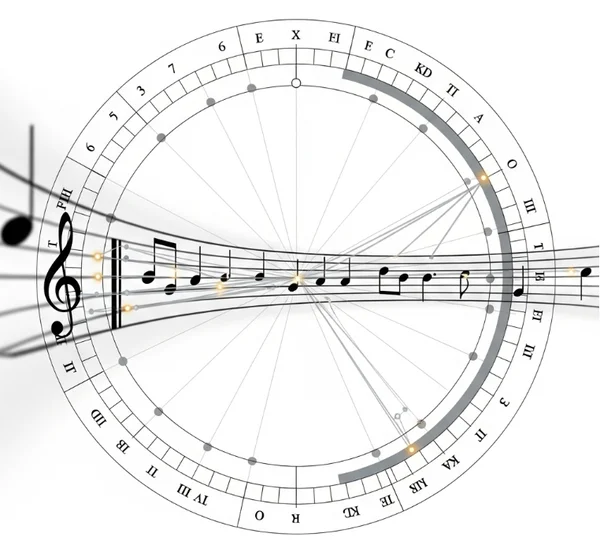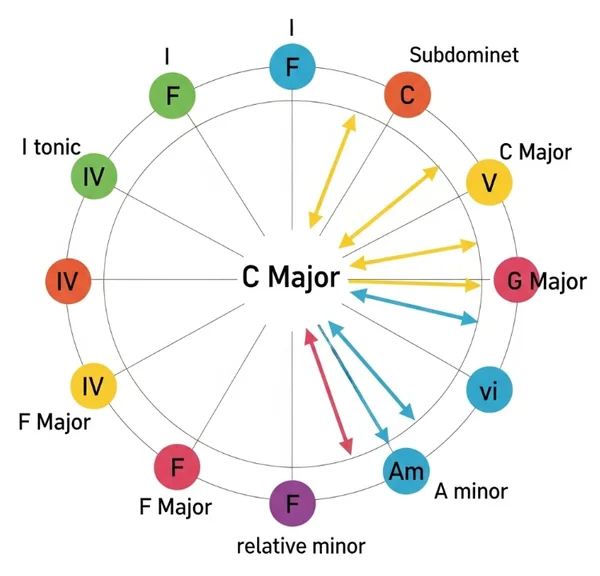Circle of Fifths in Songwriting: Craft Melodies & Harmonies
As a songwriter, are you constantly searching for ways to make your melodies more memorable and your harmonies richer? The Circle of Fifths, often seen as a fundamental music theory concept, is a powerhouse tool for exactly that. But how do I use the Circle of Fifths for songwriting effectively? This guide delves into practical songwriting circle of fifths techniques, showing you how to leverage this incredible diagram for compelling melody creation and sophisticated harmony writing. To truly unlock these concepts visually, explore our interactive Circle of Fifths tool.
Why is the Circle of Fifths a Songwriter's Best Friend?
Before we get into specific music composition techniques, let's understand why the Circle of Fifths is so crucial for songwriters. It’s more than just a chart of keys; it’s a map of harmonic relationships. Can the Circle of Fifths help with melody creation? Yes, profoundly! Understanding these relationships helps you:
- Craft melodies that feel natural and resolved.
- Build circle of fifths chords and progressions that support your melodic ideas.
- Create tension and release effectively.
- Modulate between keys smoothly to enhance song structure.
- Infuse your songs with the desired emotional impact music can convey.
The Foundation: Understanding Key Relationships for Songwriting
At its core, songwriting theory involving the Circle of Fifths starts with understanding how keys relate. Keys next to each other on the Circle are closely related, sharing many common chords. This proximity is key to smooth transitions and logical harmonic movement in your songs.
Visualizing Your Song's Journey with an Interactive Tool
An interactive circle of fifths can be invaluable. It allows you to see these key relationships songwriting principles in action, experiment with chord changes, and visualize how your melodic ideas might interact with different harmonic environments.
Crafting Melodies with the Circle of Fifths
While the Circle of Fifths is often associated with harmony, its influence on melody creation is significant.

Using Neighboring Keys for Melodic Inspiration
When you're stuck for a melodic idea, look to the keys adjacent to your song's primary key on the Circle. Notes from these closely related keys can often be introduced subtly to add color and interest to your melody without sounding jarring. This technique is great for crafting melodies that are both engaging and coherent.
Targeting Chord Tones Within Progressions
As you build chord progressions (which we'll discuss next), use the Circle to understand which notes are strong chord tones within each chord of your progression. Melodies that land on these chord tones at key moments often sound more powerful and resolved. Visualizing this with our online tool can be very helpful.
Creating Melodic Contour and Direction
The movement around the Circle (e.g., moving in fifths or fourths) can inspire melodic contours. A melody that systematically moves through roots suggested by the Circle can create a strong sense of direction and inevitability.
Building Harmony and Chord Progressions
This is where the Circle of Fifths truly shines for harmony writing. What's the best way to write harmony using the Circle of Fifths?
The Power of Proximity: Diatonic Chords
The chords most closely related to your chosen key are found right next to it on the Circle. For C Major, its neighbors F Major (IV) and G Major (V) are fundamental. Our interactive circle of fifths tool instantly shows these relationships, simplifying the process of finding diatonic circle of fifths chords.

Classic Chord Progressions on the Circle
Many famous chord progressions have a clear path on the Circle of Fifths.
- The ii-V-I: A cornerstone of jazz and pop, this involves moving counter-clockwise (e.g., Dm7-G7-Cmaj7).
- Movement in Fifths/Fourths: Progressions like Am-Dm-G-C (moving in fourths, or counter-clockwise fifths) are incredibly common and strong. Experimenting with these movements is a key part of music composition techniques.
Adding Color with Secondary Dominants and Borrowed Chords
Once you're comfortable with diatonic harmony, the Circle can help you introduce more complex circle of fifths chords. A secondary dominant is the V chord of a diatonic chord other than the tonic. The Circle makes finding these easy (e.g., to emphasize a G chord in C major, find G's V, which is D – visible on the Circle). Try visualizing these on circleoffifths.io.
Structuring Your Song and Creating Emotional Impact
The Circle of Fifths isn't just about notes and chords; it's about the bigger picture of your song. How does the Circle of Fifths influence song structure and emotion?
Modulation for Sectional Contrast
Changing keys (modulation) between sections (verse, chorus, bridge) can dramatically alter a song's mood. The Circle of Fifths provides a map for smooth modulations. Moving to a key one step clockwise (e.g., C to G) often feels brighter, while moving counter-clockwise (e.g., C to F) can feel more settled or even slightly darker. This is a powerful tool for enhancing song structure.

Tension and Release with Harmonic Movement
Movement away from the tonic on the Circle (especially several steps) can build tension. Returning towards the tonic, often via a V-I cadence (a step counter-clockwise on the Circle from V to I), creates a strong sense of release and resolution. Mastering this is key to controlling the emotional impact music has.
Using the Circle for Bridges and Transitions
Bridges often explore different harmonic territory. The Circle of Fifths can help you find interesting, related keys to visit during a bridge before returning to your main key for the final chorus. This aspect of music theory for composers is vital for dynamic songwriting.
Putting It All Together: A Songwriter's Workflow
Are there music composition techniques involving the Circle of Fifths for a full workflow? Yes!
- Establish Your Tonic: Choose your home key using the Circle.
- Explore Diatonic Chords: Use the Circle (and our tool) to map out your primary and secondary diatonic chords.
- Sketch Chord Progressions: Experiment with movements around the Circle for verses, choruses, etc.
- Craft Melodies: Write melodies that complement your chosen harmonies, targeting chord tones.
- Consider Modulations: Use the Circle to plan key changes for different sections to enhance song structure and emotional arc. Even aspects like lyric writing harmony can be influenced, as the mood set by the harmony can inspire lyrical themes.
The songwriting circle of fifths approach offers endless possibilities. Don't be afraid to experiment. Use the Circle as a guide, not a rigid set of rules.
What are your go-to Circle of Fifths techniques when writing songs? Or what new idea from this article are you excited to try? Let us know in the comments!
Songwriting with the Circle of Fifths
-
How do I use the Circle of Fifths for songwriting?
Use it to select keys, find related diatonic chords, build strong chord progressions (like ii-V-I), craft melodies that fit your harmony, plan modulations between song sections, and create emotional impact through tension and release. Our interactive tool can help visualize these steps.
-
Can the Circle of Fifths help with melody creation?
Yes, it helps by suggesting harmonically related notes for your melody, guiding melodic contour through movements in fifths/fourths, and helping you target strong chord tones within your progressions for impactful melodic moments.
-
What's the best way to write harmony using the Circle of Fifths?
Start by identifying the diatonic chords around your chosen key on the Circle. Experiment with progressions by moving to adjacent chords (fifths or fourths). Use it to find secondary dominants or borrowed chords for added color. The Circle of Fifths is a map for harmony writing.
-
Are there music composition techniques involving the Circle of Fifths?
Many! These include using it for diatonic chord selection, creating common progressions (ii-V-I, I-IV-V), planning modulations, building tension and release, and even inspiring melodic shapes. It’s a foundational tool in many music composition techniques.
-
How can an interactive Circle of Fifths tool aid songwriters?
An interactive circle of fifths tool like the one on our website allows songwriters to instantly visualize key relationships, see diatonic chords, experiment with progressions, hear how chords sound, and plan modulations, making the theoretical aspects of songwriting much more tangible and intuitive.